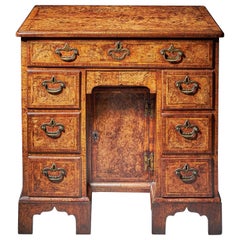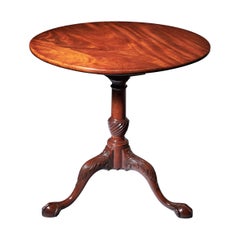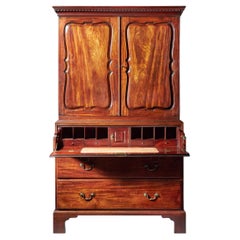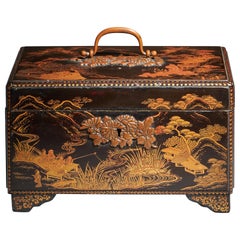Want more images or videos?
Request additional images or videos from the seller
1 of 21
The Sir William Stephenson 18th Century George II Lacquer Chinoiserie Bureau
$31,499.74List Price
About the Item
- Dimensions:Height: 40.25 in (102.24 cm)Width: 38 in (96.52 cm)Depth: 21.5 in (54.61 cm)
- Style:George II (Of the Period)
- Materials and Techniques:
- Place of Origin:
- Period:
- Date of Manufacture:1730-1740
- Condition:Wear consistent with age and use. Minor conservations in line with age and use. Remarkably, all decoration, hardware, locks and feet are original. It should be noted that the piece is in remarkable condition!
- Seller Location:Oxfordshire, GB
- Reference Number:1stDibs: LU4936243821442
About the Seller
5.0
Recognized Seller
These prestigious sellers are industry leaders and represent the highest echelon for item quality and design.
1stDibs seller since 2019
24 sales on 1stDibs
Typical response time: 1 to 2 days
Associations
LAPADA - The Association of Arts & Antiques Dealers
Authenticity Guarantee
In the unlikely event there’s an issue with an item’s authenticity, contact us within 1 year for a full refund. DetailsMoney-Back Guarantee
If your item is not as described, is damaged in transit, or does not arrive, contact us within 7 days for a full refund. Details24-Hour Cancellation
You have a 24-hour grace period in which to reconsider your purchase, with no questions asked.Vetted Professional Sellers
Our world-class sellers must adhere to strict standards for service and quality, maintaining the integrity of our listings.Price-Match Guarantee
If you find that a seller listed the same item for a lower price elsewhere, we’ll match it.Trusted Global Delivery
Our best-in-class carrier network provides specialized shipping options worldwide, including custom delivery.You May Also Like
18th Century Chinoiserie Bureau
Located in Chelmsford, Essex
For sale is a good quality 18th century and later decorated chinoiserie bureau. The fall front opening to reveal a fully fitted interior and a well, above an arrangement of four draw...
Category
Antique 18th Century English Desks
Materials
Oak
English Queen Anne, Early 18th Century Red Chinoiserie Lacquer Desk / Commode
Located in Troy, NY
A small early 18th century red lacquer chinoiserie decorated commode with a desk compartment, the hinged slant front - flip top, supported by pull-out...
Category
Antique Early 18th Century English Queen Anne Commodes and Chests of Dra...
Materials
Wood
$12,750
H 38.5 in W 25 in D 16.75 in
18th Century George II Bachelor Chest
Located in Dublin 8, IE
18th century George II figured Cuban mahogany bachelor chest of excellent compact proportions retaining excellent patina. The rectangular figur...
Category
Antique 18th Century Irish George II Commodes and Chests of Drawers
Materials
Mahogany
18th Century George II Miniature Tallboy
Located in Dublin 8, IE
18th century George II flame mahogany miniature tallboy, the moulded top over five graduated drawers with brass pulls with integrated escutcheo...
Category
Antique 18th Century Irish George II Commodes and Chests of Drawers
Materials
Mahogany
Large Antique George II Mahogany Desk c. Mid 18th Century
Located in Westfield, MA
This Large Antique George II Mahogany Desk, crafted in the mid-18th century, is an exceptional example of Georgian design, combining both form and function with timeless beauty. The ...
Category
Antique Mid-18th Century English George II Desks
Materials
Mahogany
18th Century Walnut Kneehole Desk
Located in Bedfordshire, GB
A very attractive early 18th century, George I Period, walnut kneehole desk of diminutive proportions, having extremely well figured quarter veneered, crossbanded top with elegant re-entrant corners, over arrangement of seven drawers retaining original brasswear, flanking central cupboard door with original brass hinges, raised on original bracket feet.
In general kneehole deeks are regarded as a smaller, more compact version of the more typically found pedestal desk, with some form of an arrangement of drawers around a central set recessed cupboard being the typically found form. There are of course various different designs to be found along the same theme, but as a general rule that is the form you will usually find in a georgian kneehole desk...
Category
Antique Early 18th Century English George I Desks
Materials
Walnut
Antique 18th Century George I Quality Figured Walnut Bureau
Located in Suffolk, GB
Antique 18th Century George I quality figured walnut bureau having a quality figured walnut fall with herringbone crossbanding opening to reveal a fitted interior consisting of five ...
Category
Antique 18th Century English George I Desks
Materials
Walnut
George III Bureau Desk or Secretary Chest from the 18th Century
Located in Austin, TX
A fine George III slant top desk or bureau secretary chest of elm, oak and padouk woods, c.1780 - an inlaid slant front drops to reveal a series of small drawers and document compart...
Category
Antique 18th Century English George III Secretaires
Materials
Metal, Brass
18th Century Mahogany Bureau
Located in Martlesham, GB
A superb quality 18th Century mahogany Georgian bureau, the hinged fall lifting down to reveal a lovely fitted interior consisting of eleven oak ...
Category
Antique 1780s British Georgian Desks
Materials
Mahogany
18th Century walnut bureau
Located in Martlesham, GB
A lovely quality 18th Century walnut bureau, having a lovely figured fall which opens to reveal a wonderful fitted interior consisting of various drawers and compartments, a green le...
Category
Antique 1780s British Georgian Desks
Materials
Walnut
More From This Seller
View AllRare Burr Walnut George II 18th Century Kneehole Desk, circa 1730-1740, England
Located in Oxfordshire, United Kingdom
Rare Burr walnut George II 18th century kneehole desk / bachelor's chest, circa 1730-1740. England
The superb quarter veneered burr walnut top is bordered by a fine feather stringing, cross-banded and edged with cross-grain ovolo mouldings.
Six oak lined drawers bearing their original locks and handles and escutcheons surround the central burr walnut cupboard...
Category
Antique Early 18th Century English George II Desks
Materials
Walnut, Burl
A Fine 18th Century George II Mahogany Tripod Table, Circa 1760
By Thomas Chippendale
Located in Oxfordshire, United Kingdom
This 18th century George II table features a beautifully crafted one piece circular top made from one piece of richly grained figured mahogany, showcasing the natural luster and patt...
Category
Antique 18th Century English George II Side Tables
Materials
Mahogany
18th-Century George II Mahogany Secretaire Linen Press, Attributed, Giles Grendey
By Giles Grendey
Located in Oxfordshire, United Kingdom
A fine and rare 18th century two-part George II mahogany secretaire linen press, circa 1750-1760. England. Attributed to Giles Grendey.
The de...
Category
Antique Mid-18th Century English George II Linen Presses
Materials
Brass
Rare 18th Century George III Lacquer Tea Caddy with Original Lacquer Canisters
Located in Oxfordshire, United Kingdom
This exceptional and rare George III period tea caddy is a remarkable example of 18th-century craftsmanship. Featuring intricate chinoiserie lacquer decoration, the caddy retains all...
Category
Antique 18th Century English George III Decorative Boxes
Materials
Lacquer
18th Century George I Domed Topped Japanned Chinoiserie Falconry Box, circa 1710
Located in Oxfordshire, United Kingdom
A rare and important Queen Anne-George I japanned chinoiserie domed topped box depicting scenes of falconry, circa 1710-1720. England
Falconry is ...
Category
Antique Early 18th Century English Chinoiserie Decorative Boxes
Materials
Oak
17th Century William and Mary Olive Oyster Chest on Stand or Table Box
Located in Oxfordshire, United Kingdom
A fine and extremely rare 17th century William and Mary baroque olive oyster chest on stand or 'table box', circa 1675-1690.
The exquisite...
Category
Antique Late 17th Century English William and Mary Commodes and Chests o...
Materials
Olive
Recently Viewed
View AllMore Ways To Browse
18th Century Oak Bureaus
Antique Silver Fobs
Furniture With Hidden Compartments
John Hodgson
Dux Desk
George Nelson Executive Desk
Hong Kong Wood Desk
Leather Knee Hole Desk
Maple Drop Front Desk
Maple Slant Front Desk
Mengel Desk
Mid Century Leopold Desk
Modesty Panel Desk
Monteverdi Young Executive Desk
Oak Double Pedestal Desk
Pierre Chareau Desk
Pop Up Davenport
Scandinavian Roll Top Desk



